Paper Menu >>
Journal Menu >>
 Advances in Pure Mathematics, 2011, 1, 286-294 doi:10.4236/apm.2011.15052 Published Online September 2011 (http://www.SciRP.org/journal/apm) Copyright © 2011 SciRes. APM Squares from D(–4) and D(20) Triples Zvonko Čerin Kopernikova 7, Zagreb, Croatia E-mail: cerin@math.hr Received May 5, 2011; revised May 20, 2011; accepted June 1, 2011 Abstract We study the eight infinite sequences of triples of natural numbers 2123 27 ,4 , nnn AFF F , 21 , n BF 25 27 4, nn FF , 21 2123 ,5 ,4 nnn CF FF, 23 21 ,4 ,5 nn DF F23n F and 21 23, 27 , nnn L ,4LL 21 ,4LL25 27nnn , ,L 21 21, 23n L,5 nn LL,4 2321 23. The sequences and ,4LL,5 nnn L,,ABC D are built from the Fibonacci numbers n F while the sequences , , and from the Lu- cas numbers n. Each triple in the sequences L,, A BC and D has the property (i. e., adding 4D4 to the product of any two different components of them is a square). Similarly, each triple in the sequences , , and has the property . We show some interesting properties of these sequences that give various methods how to get squares from them. 20D Keywords: Fibonacci Numbers, Lucas Numbers, Square, Symmetric Sum, Alternating Sum, Product, Component 1. Introduction For integers , and c, let us write provided ab b ac 2 =ab c. For the triples =,, X abc , =,,Ydef and =,, X abc the notation Y X X means that , and d bc a e ca b f ab c . When , let us write ,kk =,Yk k X X for Y X X . Hence, X is the Dk tri- ple (see [1] ) if and only if there is a triple X such that k X X . We now construct the infinite sequences A , , and of the Driples and , and the Diples. They are B ,4 C 23 ,F D 4- -tr t of , AF 21 20 nn 21 , , , 27n F 25 27 , nnn F F 21 ,4BF21 ,5 FCF nn , and 23n 4F 23n23 ,4DF 21 ,5 nn F F 21 , n L , , 27n23 4, n LL 7n21 25 ,4 nn LL 2 ,L 21 , n L 2123 , 2321 23nnn , where the Fibonacci and Lucas sequences of natural numbers 4 nn L 5,L L,4LL,5 n F and n are defined by the recurrence relations , , 2n L =1 0 F=0 1 F1 = nn F FF L for and , , for . 2n 2 n0 L=2 1 L=1 = n12nn The numbers k LL F make the integer sequence from [2] while the numbers make . For an integer , let us use , 000045A 000032A k L k kπk , and for , , k p k r2nk F2 Lnk4 Fnk and . 4 Lnk The goal of this article is to explore the properties of the sequences A , , , , , , and . Each member of these sequences is an Euler BCD 4D - or 20D-triple (see [3]) so that many of their properties follow from the properties of the general (pencils of) Euler triples (see [4,5] ). It is therefore interesting to look for those properties in which at least two of the sequences appear. This paper presents several results of this kind giving many squares from the components, various sums and products of the sequences A , , , , , , and . Most of our theorems have also versions for the associated sequences BC D 2 π 54 ,π=2πA ,2 , 3 ,2π 64 ,π=2πB , 2 , 2 2π,=2C 1 , 23 2 =2 , ,2πD and 54 2 2, ,2 , 64 3 =2 ,,2 , 221 =10π,2 ,5π , 2 =10π, 32 5π,2 that satisfy the relations 4 A A 20 4 , , , and , , , . BB 20 4 CC 4 DD 20 20 The overall principle in this paper is that if you can get complete squares by adding a fixed number to the prod- ucts of different components of some triples of natural numbers then you will be able to get complete squares by adding some other fixed numbers to all kinds of expres- sions and constructions built from the components of these triples. Our task was to find out these numbers and to identify those expressions and constructions. All results in this paper are identities among Fibonacci 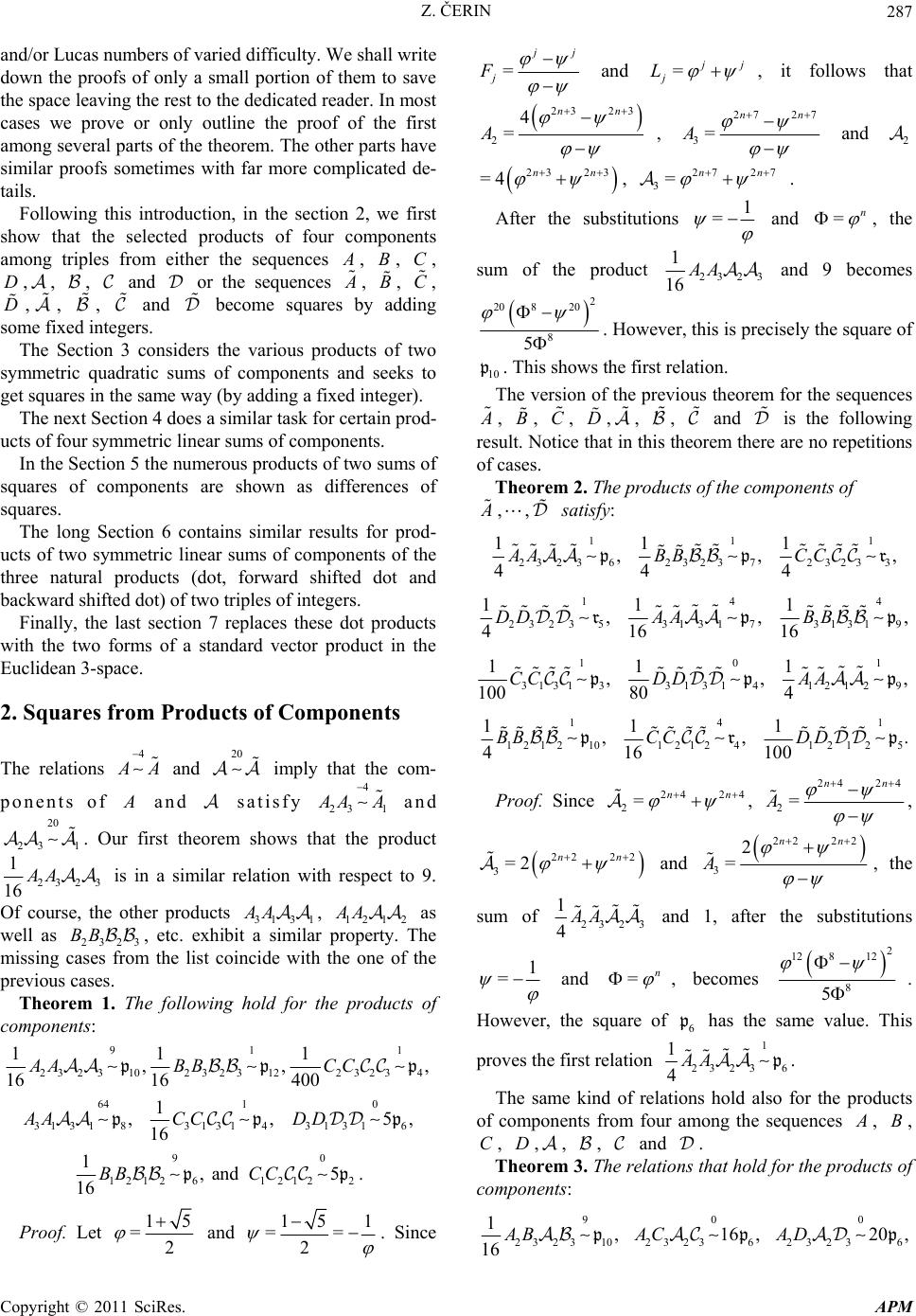 Z. ČERIN 287 and/or Lucas numbers of varied difficulty. We shall write down the proofs of only a small portion of them to save the space leaving the rest to the dedicated reader. In most cases we prove or only outline the proof of the first among several parts of the theorem. The other parts have similar proofs sometimes with far more complicated de- tails. Following this introduction, in the section 2, we first show that the selected products of four components among triples from either the sequences A , , , ,, , and or the sequences BC D A , , , ,, , and become squares by adding some fixed integers. B C D The Section 3 considers the various products of two symmetric quadratic sums of components and seeks to get squares in the same way (by adding a fixed integer). The next Section 4 does a similar task for certain prod- ucts of four symmetric linear sums of components. In the Section 5 the numerous products of two sums of squares of components are shown as differences of squares. The long Section 6 contains similar results for prod- ucts of two symmetric linear sums of components of the three natural products (dot, forward shifted dot and backward shifted dot) of two triples of integers. Finally, the last section 7 replaces these dot products with the two forms of a standard vector product in the Euclidean 3-space. 2. Squares from Products of Components The relations 4 A A and imply that the com- ponents of 20 A and satisfy 4 23 1 A AA and . Our first theorem shows that the product 20 23 1 23 2 3 1 16 AA is in a similar relation with respect to 9. Of course, the other products 31 3 1 , 121 2 as well as 2323 , etc. exhibit a similar property. The missing cases from the list coincide with the one of the previous cases. AAAA BB Theorem 1. The following hold for the products of components: 91 23 2 31023231223234 111 ,, 1 16 16 400 AA BBCC pp ,p 641 0 31 3 183131431 3 16 1 ,, 16 AACC DDpp 5,p 90 1212 612122 1, and 5 16 BB CCp p . Proof. Let 15 =2 and 15 1 == 2 . Since = j j j F and = j j j L , it follows that 2323 2 4 = nn A , 27 3=A 27nn and 2 23 23 =4 nn , . 27 3= 27nn After the substitutions 1 = and =n , the sum of the product 23 2 3 1 16 AA and 9 becomes 2 20 820 8 5 . However, this is precisely the square of . This shows the first relation. 10 p The version of the previous theorem for the sequences A , , , ,, , and is the following result. Notice that in this theorem there are no repetitions of cases. B C D Theorem 2. The products of the components of A ,, satisfy: 11 23 2 362323723233 111 ,, 444 AABB CC pp 1 ,r 14 23 23531 3 1731319 111 ,, 41616 DDAA BB rp 4 ,p 10 3131 33131 412129 11 1 ,, 100 804 CCDDAA pp 1 ,p 14 121210121241 2 125 111 ,, 416100 BB CC DD pr 1 .p Proof. Since 24 24 2=nn , 24 24 2= nn A , 22n22 3=2 n and 22 22 3 2 =A nn , the sum of 232 3 1 4AA and 1, after the substitutions 1 = and =n , becomes 2 12 812 8 5 . However, the square of has the same value. This proves the first relation 6 p 1 23 2 36 p 1 4AA . The same kind of relations hold also for the products of components from four among the sequences A , , , ,, , and . B CD Theorem 3. The relations that hold for the products of components: 90 23 231023 2362 3 2 36 1,16, 0 20 16 AB ACAD pp p , Copyright © 2011 SciRes. APM 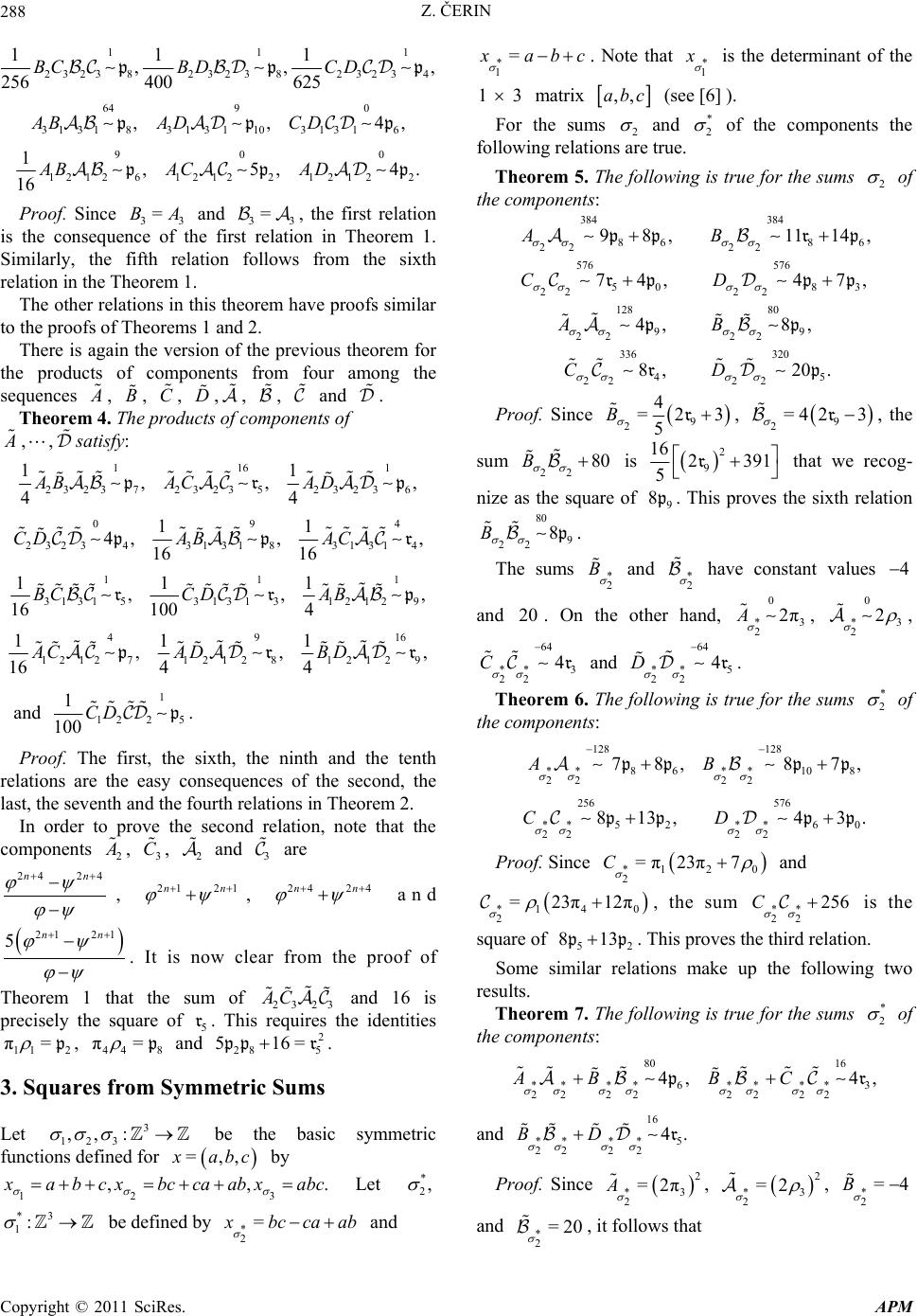 Z. ČERIN 288 111 ,p 23238232382 3234 11 1 ,, 256 400625 BC BDCDpp 4,p 64 90 313183 13 1103 13 16 ,,AB ADCDpp 90 12 12612 12212 1 22 1,5, 16 AB ACADpp 0 4.p Proof. Since 33 and 33 , the first relation is the consequence of the first relation in Theorem 1. Similarly, the fifth relation follows from the sixth relation in the Theorem 1. =BA = The other relations in this theorem have proofs similar to the proofs of Theorems 1 and 2. There is again the version of the previous theorem for the products of components from four among the sequences A , , , ,, , and . B C D Theorem 4. The products of components of A ,,satisfy: 116 23 23723 2352 3 2 36 11 ,, 44 AB ACAD pr 1 ,p 094 r 23 234313183131 4 11 4,, , 16 16 CDAB AC pp 11 3131 53131 312129 111 ,, 16 1004 BCCDAB rr 1 ,p 491 121271212 81212 9 111 ,, 16 44 ACAD BD pr 6 ,r and 1 12 25 1 100 CD p. Proof. The first, the sixth, the ninth and the tenth relations are the easy consequences of the second, the last, the seventh and the fourth relations in Theorem 2. In order to prove the second relation, note that the components 2 A , , and are 3 C 2 3 24 24 nn , , and 21 21nn 24 24nn 21 21 5nn . It is now clear from the proof of Theorem 1 that the sum of 23 23 and 16 is precisely the square of 5. This requires the identities AC r 11 2 π= p, 44 8 π= p and . 2 5 516=r 28 pp 3. Squares from Symmetric Sums Let be the basic symmetric functions defined for 3 123 ,,: =,, x abc by 12 3 ,, . x abc xbc caab xabc Let * 2, be defined by *3 1: * 2 = x bc ca ab and * 1 = x abc . Note that * 1 x is the determinant of the 1 3 matrix ,,abc (see [6] ). For the sums 2 and * 2 of the components the following relations are true. Theorem 5. The following is true for the sums 2 of the components: 384 384 868 6 22 22 576 576 50 83 222 2 128 80 99 22 22 336 320 45 222 2 98, 1114, 74, 47, 4, 8, 8, 20. AB CD AB CD pprp rp pp pp rp Proof. Since 9 2 4 =2 3 5 B r, 9 2=4 23 r, the sum 2280B is 2 9 16 2391 r that we recog- 5 nize as the square of . This proves the sixth relation 9 8p 80 9 22 8B p. The sums * 2 B and * 2 have constant values 4 and . On the other hand, , 20 0 *3 2 2πA 0 2 2 *3 , 64 ** 22 3 4C r and . 64 4D r ** 22 5 Theorem 6. The following is true for the sums * 2 of the components: 128 128 **8 6**108 22 22 78,8 7AB ppp p, . 256 576 **52* *60 222 2 813,4 3CD pp pp Proof. Since *120 2 =π23π7C and *1 40 2 =23π12π , the sum is the ** 22 256C square of 5 813 2 pp. This proves the third relation. Some similar relations make up the following two results. Theorem 7. The following is true for the sums * 2 of the components: 80 16 ****6****3 2 2222222 4, 4, AB BCpr and 16 *** *5 222 2 4.BD r Proof. Since , 2 *3 2 =2πA 2 *3 2 =2 , * 2 =4B and , it follows that * 2 =20 Copyright © 2011 SciRes. APM 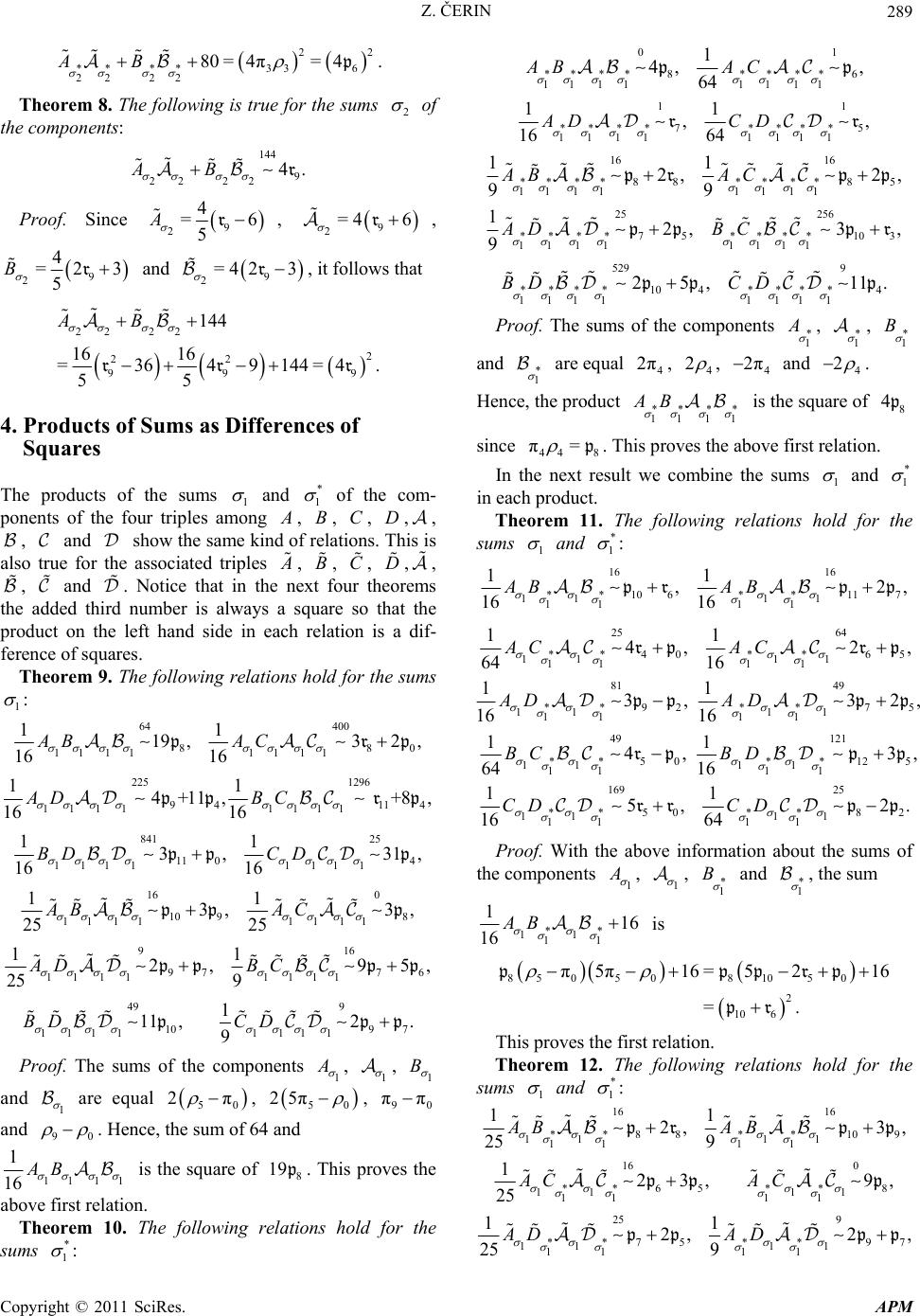 Z. ČERIN 289 22 ** **336 22 22 80 =4π=4AB p . Theorem 8. The following is true for the sums 2 of the components: 144 9 2222 4.AB r Proof. Since 9 2 4 =6 5 A r, 9 2=4 6 r , 9 2 4 =2 3 5 B r and 3 9 2=42 r, it follows that 22 22 2 22 99 144 16 16 =3649144=4 55 AB rr 9 .r 4. Products of Sums as Differences of Squares The products of the sums 1 and * 1 of the com- ponents of the four triples among A , , , ,, , and show the same kind of relations. This is also true for the associated triples BCD A , , , ,, , and . Notice that in the next four theorems the added third number is always a square so that the product on the left hand side in each relation is a dif- ference of squares. B C D Theorem 9. The following relations hold for the sums 1 : 64 400 880 p 11 1111 11 11 19 ,32 , 16 16 AB AC pr 225 1296 94 11 1111 1111 11 4+11, +8, 16 16 AD BC pp rp 4 841 25 11 04 1111 1111 11 3, 31 16 16 BD CD pp p , 16 0 10 98 11 1111 11 11 3, 3, 25 25 AB AC pp p 91 977 6 1111 1111 11 2, 95 25 9 AD BC ppp p 6 , 49 9 109 7 1111 1111 1 11 ,2. 9 BD CD ppp Proof. The sums of the components 1 A , 1 , 1 B and 1 are equal , 50 2π 50 25π , 90 ππ and 90 . Hence, the sum of 64 and 11 11 1 16 AB is the square of . This proves the above first relation. 8 19p Theorem 10. The following relations hold for the sums * 1 : 01 ** **8** **6 11 1111 11 1 4, , 64 AB AC pp 11 **** 7**** 5 1111 1111 11 ,, 16 64 AD CD rr 16 16 ** **88** **85 11 1111 11 11 2,2 , 99 AB AC pr pp 25 256 ****75****10 3 1111 1111 12,3 , 9AD BC pp pr 529 9 ****10 4****4 1111 1111 25,11BD CD pp p . Proof. The sums of the components * 1 A , * 1 , * 1 B and * 1 are equal , 4 2π4 2 , and 4 2π4 2 . Hence, the product ** ** 11 11 AB is the square of 8 4p since 44 8 π= p. This proves the above first relation. In the next result we combine the sums 1 and * 1 in each product. Theorem 11. The following relations hold for the sums 1 and * 1 : 16 16 **106** 11 11 11 11 11 11 ,2 16 16 AB AB prpp 7 , 25 64 **40* *6 11 11 111 1 11 4, 2 64 16 5 , AC ACrp rp 81 49 **92 **7 11 11 11 11 11 3, 35 ,2 16 16 AD ADppp p 49 121 **50* *12 111 1 111 1 11 4,3 64 16 BC BD rpp p 5 , 169 25 **50** 82 11 11 11 11 11 5, 2 16 64 CD CD rrp p . Proof. With the above information about the sums of the components 1 A , 1 , * 1 B and * 1 , the sum ** 11 11 116 16 AB is 850508 1050 2 10 6 π5π16 =5216 =. ppp pr rp This proves the first relation. Theorem 12. The following relations hold for the sums 1 and * 1 : 16 16 **88** 109 11 11 11 11 11 2,3 , 25 9 AB AB prp p 16 0 **65* * 11 11 111 1 123, 9 25 AC AC pp p 8 , 25 9 **75**9 11 11 11 11 11 2,2 7 25 9 AD AD , pp pp Copyright © 2011 SciRes. APM  Z. ČERIN 290 576 16 **8* *8 11 11 111 1 1 11 ,34, 9 BC BC p 7 pp 5 , 1089 1 ** 77**12 11 11 11 11 25, 3BD BD prpr 25 121 **95** 10 11 11 11 11 1,8 9CDCD prp p 6 . Proof. The sums of the components 1 A , 1 , * 1 B and * 1 are equal , 4 5π4 5 , 90 ππ 1 2 and 9 0 1 2 . Hence, the sum of the product 1 * 11 1 1 25 AB and 16 is 890 9 0 2 8189 088 1ππ 16 4 1 =216=2 4 p ppp ppr . This proves the above first relation. 5. Squares from the Sums of Squares For a natural number , let the sums >1k *3 ,: kk of powers be defined for =,, x abc by =kkk k x abc and * k =kkk x abc We proceed with the version of the Theorem 9 for the sums . 2 of the squares of components. Theorem 13. The following relations are true for the sums 2 : 224 224 10 5114 22 22 11 43, 72 44 AB pr pp , 416 416 50 3 222 2 11 74, 74 44 CD rprp 8 , , 8 . 288 288 10 5114 22 22 43,72AB pr pp 672 672 50 3 222 2 74, 74CD rp rp Proof. Since 2 A and 2 are 80 2272 18 5pp and , the difference of 80 227218pp 22 A and 896 is equal 22 8 5212840 , where and are 320767143451 5 and 4 38 253 567 5. 10 But, one can easily check that this is the square of 5 86 pr. This concludes the proof of the first relation. The next is the version of the Theorem 13 for the alternating sums * 2 of the squares of components. Theorem 14. The following relations are true for the sums * 2 : 384 96 **66**6 8 22 22 1 119 ,25 , 4 AB pr pr 24 416 **51* *80 222 2 11 2,2 , 64 4 CD rp rr 224 224 **76**9 10 22 22 7, 7AB rp rp, . 128 160 **38* *60 2222 8, 43CD rpp p Proof. Notice that the alternating sums of squares of components * 2 A and * 2 are 50 2252 14 5 rr and 50 2252 14rr . Hence, the sum of ** 22 A and 384 is equal 2 8 8 7798334875 51427798334875 5 . 50410 However, one can easily check that this is the square of 6 119 6 pr. This proves the first relation. Multiplied by five these products of the sums * 2 of components show the same behavior. Theorem 15. For the sums * 2 , the following relations hold: 196 196 **114**118 22 22 55 34, 314 44 AB ppp p , 44 **82* *80 2222 51 6,2, 64 20 CD pp pp 44 **106** 125 22 22 5511,545AB pr rp, 3. 1444 1764 **92**60 222 2 5225,5 4CD rp rr Proof. With the above values of * 2 A and * 2 , the sum of ** 22 5A and 784 is equal 2 8 8 7798334875 51427798334875 5 . 10082 But, this is the square of 11 4 68 pp. This outlines the proof the first relation. 6. Squares from the Products , and Let us introduce three binary operations , and on the set of triples of integers by the rules 3 ,,,,=, ,,abcuvw aubvcw Copyright © 2011 SciRes. APM 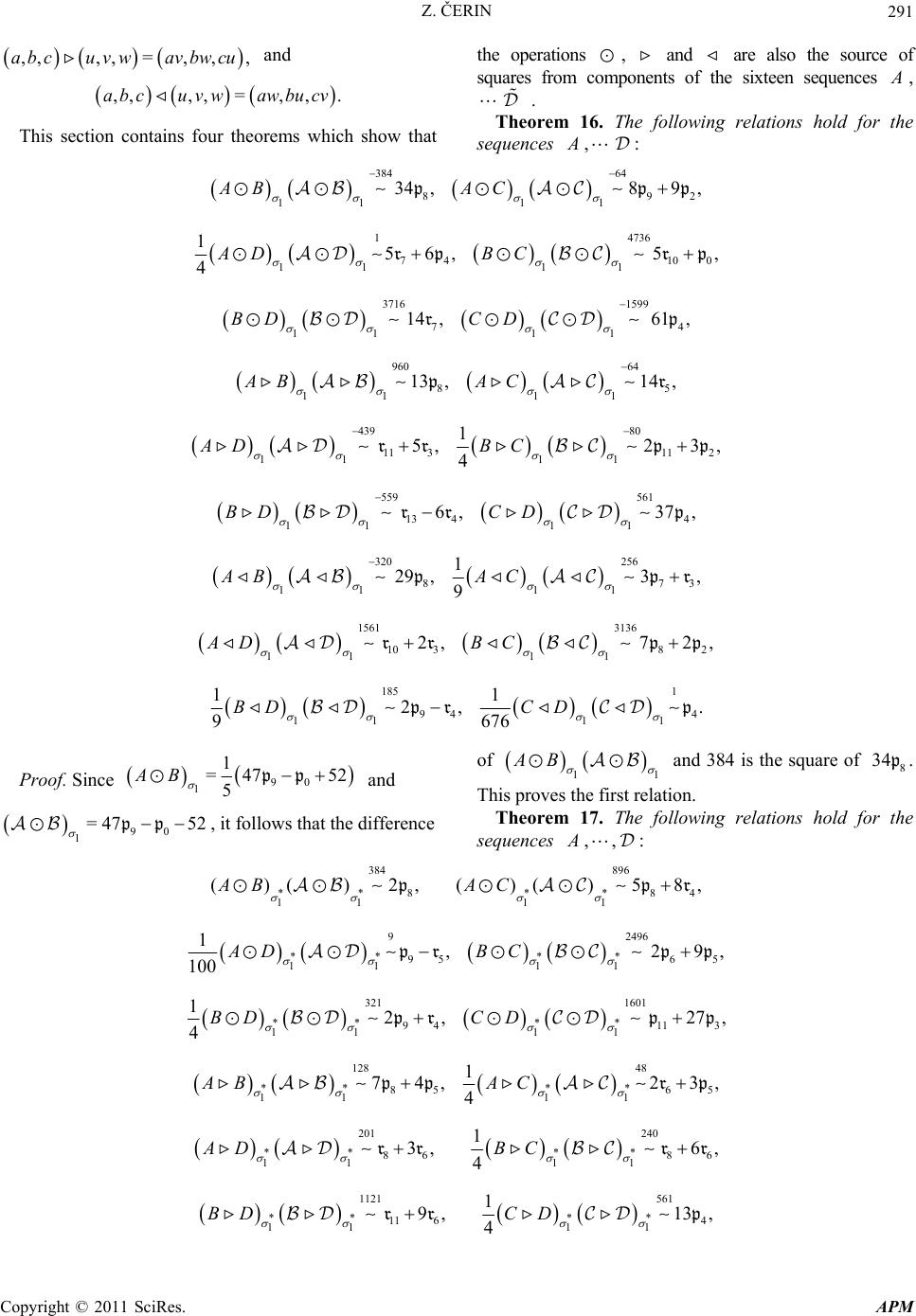 Z. ČERIN Copyright © 2011 SciRes. APM 291 ,,,,=,,,abc uvwavbwcu and the operations , and are also the source of squares from components of the sixteen sequences A , . ,,,,=, ,.abc uvwawbucv Theorem 16. The following relations hold for the sequences A ,: This section contains four theorems which show that 384 64 89 11 11 34 ,89,AB AC pp 2 p 74 10 11 11 156, 5 4AD BC rprp 1 4736 0 , 3716 1599 74 11 11 14 ,61,BD CD rp 960 64 85 11 11 13,14 ,AB AC pr 11 311 2 11 11 1 5,23 , 4 AD BC rr pp 439 80 559 561 13 4 4 11 11 6,37 ,BD CD rrp 87 11 11 1 29 ,3, 9 AB AC 320 256 3 pp r 1561 3136 10 382 11 11 2,72 ,AD BC rr pp 185 1 94 4 11 11 11 2, 9676 BD CD pr p . of 11 A B and 384 is the square of . This proves the first relation. 8 34p Proof. Since 90 1 1 =47 52 5 AB pp and , it follows that the difference 90 1=47 52 pp Theorem 17. The following relations hold for the sequences A ,,: 384 896 **8 **8 11 11 ()()2,()()58AB AC pp 4 ,r ** ** 956 5 11 11 1,2 100 AD BC prp p 9 2496 9, 321 1601 ** ** 94113 11 11 12, 27 4BDCD prp p , 128 48 ** ** 85 6 11 11 1 74,23 4 AB AC pp rp 5 , 201 240 ** ** 86 86 11 11 1 3, 6, 4 AD BC rr rr 1121 561 ** ** 11 64 11 11 1 9,13 , 4 BD CD rr p 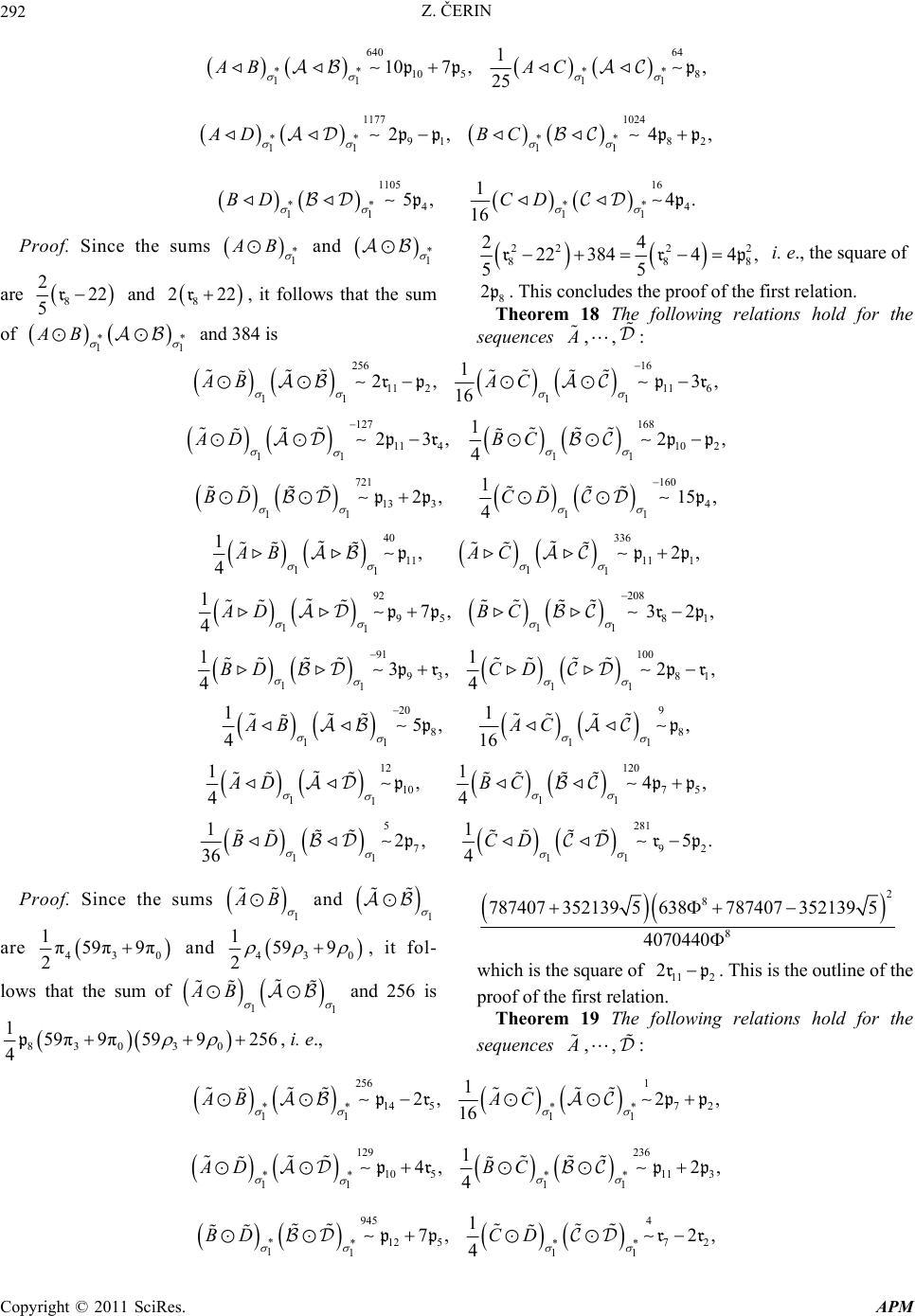 Z. ČERIN 292 640 64 ** ** 10 58 11 11 1 107 ,, 25 AB AC pp p ** ** 918 2 11 11 2, 4ADBC pp pp 1177 1024 , ** ** 44 11 11 1 5, 4. 16 BD CD pp 1105 16 Proof. Since the sums * 1 A B and * 1 are 8 222 5r * and , it follows that the sum 8 222r of * 11 AB and 384 is 22 2 88 24 2238444 , 55 rr 2 8 p i. e., the square of 8 Theorem 18 The following relations hold for the sequences 2p. This concludes the proof of the first relation. A ,, : 256 16 11 2116 11 11 1 2,3 16 AB AC rpp r, 127 168 11410 2 11 1 1 23,2 4 AD BC pr pp 1 , 721 160 13 34 111 1 2, 15, 4 BD CD pp p 1 40 336 1111 1 11 11 1,2 4AB AC pp ,p 92 208 95 8 11 1 17,3 2, 4AD BC pp rp 1 1 91 100 93 81 1111 11 3,2 44 BD CD , pr pr 20 9 88 11 11 11 5, , 416 AB AC pp 12 120 107 5 11 1 11 ,4 44 AD BC pp 1 , p 5 281 79 1111 11 2, 5. 36 4 BD CD pr 2 p Proof. Since the sums 1 A B and 1 are 430 1π59 π9π 2 and 43 159 9 2 0 , it fol- lows that the sum of 11 AB and 256 is 83030 159π9π59 9256 4 p, i. e., 2 8 8 787407352139 5638787407352139 5 4070440 which is the square of 11 2 2 rp. This is the outline of the proof of the first relation. Theorem 19 The following relations hold for the sequences A ,,: 256 1 1457 2 ** ** 11 11 1 2,2, 16 AB AC pr pp 10 511 3 ** * 11 1 1 4,2 , 4 AD BC pr pp 129 236 * 1 12 572 *** 111 1 7, 2, 4 BD CD pp rr 945 4 * 1 Copyright © 2011 SciRes. APM 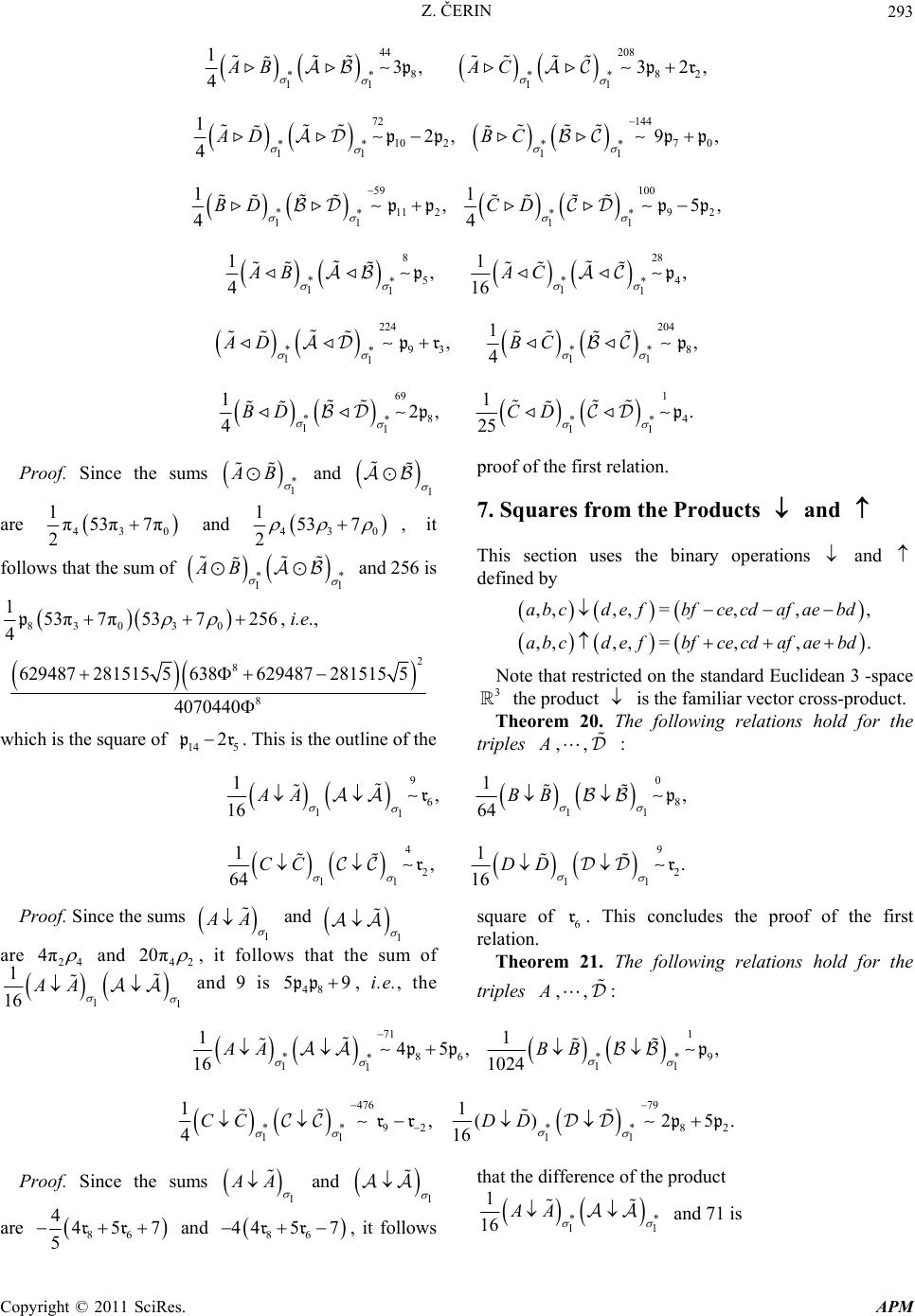 Z. ČERIN 293 44 208 88 ** ** 11 11 13,3 2, 4AB AC pp 2 r 10 270 ** * 11 1 12,9 , 4AD BC pp pp 72 144 * 1 11 29 2 **** 1111 11 ,5 44 BD CD ppp p 59 100 , 54 ** ** 11 11 11 ,, 416 AB AC pp 828 93 8 ** * 11 1 1 ,, 4 AD BC pr p 224 204 * 1 84 *** 111 11 2, . 425 BD CD pp 69 1 * 1 Proof. Since the sums * 1 A B and 1 are 430 1π53π7π 2 and 0 7 43 153 2 ** 11 , it follows that the sum of AB and 256 is 30 7 256 830 153π7π53 4p, i.e., 2 8 8 629487281515 5638629487281515 5 4070440 which is the square of . This is the outline of the 14 5 2p proof of the first relation. 7. Squares from the Products and This section uses the binary operations and defined by ,,,, =,,, ,,,, =,,. abcde fbfcecdafaebd abcde fbfcecdafaebd Note that restricted on the standard Euclidean 3 -space the product is the familiar vector cross-product. 3 Theorem 20. The following relations hold for the triples A ,, : r 90 68 1 11 1 11 ,, 16 64 AA BB rp 22 1 11 1 11 ,. 64 16 CC DD rr 49 Proof. Since the sums 1 A A and 1 are 24 4π and 42 20π , it follows that the sum of 11 1 16 AA and 9 is , i.e., the 48 5pp 9 6 r square of . This concludes the proof of the first relation. Theorem 21. The following relations hold for the triples A ,,: 71 1 86 9 * * * *1 1 1 1 11 45, 16 1024 AA BB pp p , 476 79 92*82 ** * 1 11 1 11 ,( )25 416 CC DD rrp p . Proof. Since the sums 1 A A and 1 are 86 4457 5 rr and , it follows that the difference of the product 86 44 5rr 7 ** 11 1 16 AA and 71 is Copyright © 2011 SciRes. APM  Z. ČERIN 294 2 86 14 5404 5 rr which simplifies to 2 8 8 3854117236 51013854117236 5 51005 i.e., to the square of 86 45 pp. This proves the first relation. Notice that, in our final result, the third added constant value is in all cases the complete square. Theorem 22. The following relations hold for the triples A ,, : 22 84 88 11 11 119 ,139 , 4AB AC pp 0 2 p 30 36 82 102 11 11 1 79,4 3 4 AD BC rpp p 22 , 29 5 10 64 11 11 11 18,31 , 44 BD CD rp p 22 84 88 11 11 121,320 , 4AB AC pp 22 8 5 r 67 93 81 11 11 13,11 6, 25 AD BC rp rp 22 2 27 19 10 64 11 11 126,63 . 4BDCD rp p 22 Proof. Since the sums 1 A and 1 B are 11 4 23 2pr and , it follows that the sum 14 8 212pp of the product 11 1 4 AB and 64 is which simplifies to the square of . This proves the first relation. 114148 3 21264prp p 8 19p 8. References [1] E. Brown, “Sets in Which x yk Is Always a Square,” Mathematics of Computation, Vol. 45, No. 172, 1985, pp. 613-620. [2] N. Sloane, On-Line Encyclopedia of Integer Sequences. http://www.research.att.com/ njas/sequences/. [3] L. Euler, “Commentationes Arithmeticae I,” Opera Om- nia, Series I, volume II, B.G. Teubner, Basel, 1915. [4] Z. Čerin, “On Pencils of Euler Triples I,” (in press). [5] Z. Čerin, “On Pencils of Euler Triples II,” (in press). [6] M. Radić, “A Definition of Determinant of Rectangular Matrix,” Glasnik Matematic, Vol. 1, No. 21, 1966, pp. 17-22. Copyright © 2011 SciRes. APM |

